


Synthesis of potassium from magnesium
This is an interesting and also remarkable synthesis of potassium, which can be carried out at very mild conditions and which only requires reactants which are not really hard to obtain. This synthesis was first described in a patent (United States Patent 4725311, published February 16, 1988) and successfully carried out at the end of 2010 by a home chemist, known by his nickname 'Pok' on the German home chemistry forum Versuchschemie:
http://www.versuchschemie.de/topic,14677,-Synthese+von+Kalium.html.
This synthesis of potassium is not the most efficient one in terms of used chemicals and used amounts of energy, but the interesting thing about this reaction is that it can be carried out using very simple equipment.
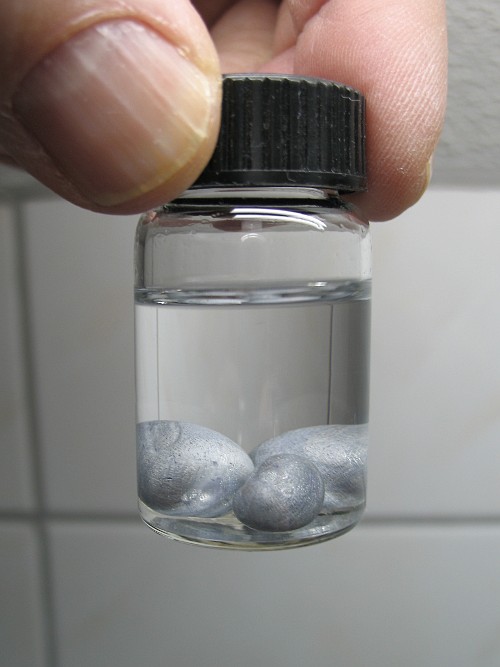
![]()
![]() Required
chemicals:
Required
chemicals:
-
magnesium (fine filings or coarse powder, particle size appr. 100 μm)
-
potassium hydroxide
-
tert-butanol
-
aliphatic solvent, free from aromatics with a boiling range centered around 220 °C.
The choice of solvent is important. The solvent must not be too viscous, it must be totally saturated and it must have a high percentage of compounds boiling near 200 C. A suitable brand is Shellsol D70, which is a mix of alkanes and cycloalkanes in the range C11 ... C14 and a boiling range of 190 to 245 °C. If a replacement for Shellsol D70 is used, then be sure that it meets the requirements as described above.
![]() Required
equipment:
Required
equipment:
-
hot plate and pan
-
clean dry sand
-
thermometer which includes the range from 100 °C to 300 °C
-
erlenmeyer, rubber stopper with a hole and a glass tube which can be used as reflux cooler. An even better setup is an erlenmeyer with ground glass joint and a cooler, which can be attached to that. In the latter setup of course no stopper is needed.
-
small funnel with a tube diameter less than the inner diameter of the reflux cooler
![]() Safety:
Safety:
-
magnesium is very flammable
-
potassium hydroxide is corrosive. Avoid contact with the skin. If this comes in contact with the skin, immediately rinse with water, until the slippery feeling has gone.
-
tert-butanol is flammable and its vapor is harmful when breathed too much
-
high temperatures of around 200 °C are used. Avoid touching hot parts during the experiment
-
the potassium formed in the experiment is highly reactive and immediately catches fire when it comes in contact with water and it may even cause explosion when brought in contact with water
![]() Disposal:
Disposal:
-
When the largest spheres of potassium are taken out of the liquid, then one can add a few ml of tert-butanol and swirl the erlenmeyer. Let this stand overnight in a loosely stoppered erlenmeyer to be sure that all tiny specks of potassium are destroyed. Do not skip this step. Without this treatment the waste introduces an unacceptable high risk of fire due to the presence of very small globules of potassium.
-
Next, take several pieces of paper tissue and put them in a plastic bag and pour the contents of the erlenmeyer on this paper tissue. All liquid must be absorbed, there must be no free flowing liquid. Add more paper tissue when needed.
-
Tightly close the plastic bag and put this in the household waste. This way of disposal is safe and not environmentally bad. None of the used chemicals is particularly toxic and when the household waste is burned, then all of it is destroyed.
![]()
Setting up the experiment
The amounts, described below allow the experiment to be carried out in a 100 ml erlenmeyer. The quantities used are not critical, a deviation of 10% or so is not a problem.
![]() Take
approximately 3.5 grams of magnesium and put that in an erlenmeyer of 100 ml.
Take
approximately 3.5 grams of magnesium and put that in an erlenmeyer of 100 ml.
![]() Take approximately 7 grams of potassium hydroxide and also
put that in the erlenmeyer. Just add that to the magnesium. The addition of the
potassium hydroxide must be done quickly. It is very hygroscopic and if it is
kept in contact with air, then it picks up water.
Take approximately 7 grams of potassium hydroxide and also
put that in the erlenmeyer. Just add that to the magnesium. The addition of the
potassium hydroxide must be done quickly. It is very hygroscopic and if it is
kept in contact with air, then it picks up water.
![]() Pour approximately 50 ml of the aliphatic solvent over the
magnesium and potassium hydroxide.
Pour approximately 50 ml of the aliphatic solvent over the
magnesium and potassium hydroxide.
![]() In a
separate little bottle, mix approximately 7.5 ml of aliphatic solvent with 0.6
to 0.7 ml of tert-butanol. Do not yet mix this with the contents of the
erlenmeyer. Keep it aside, it is needed lateron.
In a
separate little bottle, mix approximately 7.5 ml of aliphatic solvent with 0.6
to 0.7 ml of tert-butanol. Do not yet mix this with the contents of the
erlenmeyer. Keep it aside, it is needed lateron.
![]() Pour some clean and dry sand in a small pan and put this on a
hot plate. Use so much sand that a layer of around 4 cm is obtained. It is best
to have a hot plate with multiple settings for temperature. This makes
temperature control a little more easy. Otherwise you have to switch off and on
the hot plate yourself, such that the temperature remains in the range from 200
to 250 °C.
Pour some clean and dry sand in a small pan and put this on a
hot plate. Use so much sand that a layer of around 4 cm is obtained. It is best
to have a hot plate with multiple settings for temperature. This makes
temperature control a little more easy. Otherwise you have to switch off and on
the hot plate yourself, such that the temperature remains in the range from 200
to 250 °C.
![]() Stick the thermometer in the sand and put the erlenmeyer in
the sand as well. Stopper the erlenmeyer and attach the cooler.
Stick the thermometer in the sand and put the erlenmeyer in
the sand as well. Stopper the erlenmeyer and attach the cooler.
The total setup looks as follows:

The following picture shows the erlenmeyer, covered by sand. It also shows how the thermometer is sticking into the sand.
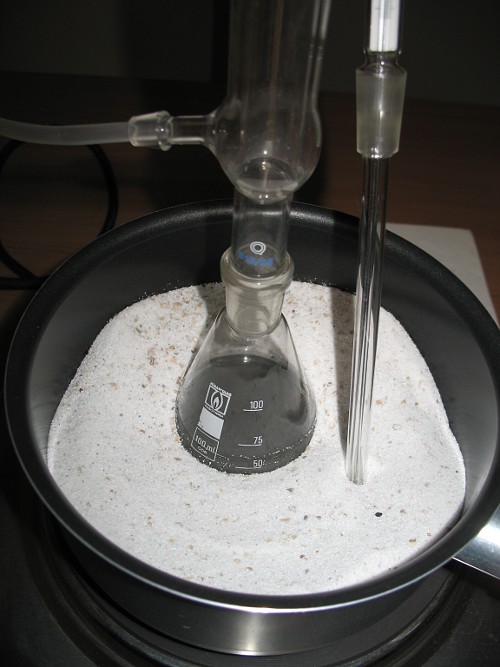
In the pictures, a Liebig cooler with ground glass joint is used as a reflux cooler, but if no such cooler is available, then one can also use a rubber stopper with a long glass tube sticking though it. The Liebig cooler was not cooled with water, a simple aquarium pump was used to blow cold air through the cooler with a speed of 2 liter per minute. If a simple glass tube is used, then no additional gear is needed.
![]()
First step, heating up and driving off water
When the apparatus is setup and the erlenmeyer is in the sand, then the hot plate can be switched on. The temperature slowly rises. When the temperature reaches 130 °C then the first activity can be observed in the erlenmeyer. The liquid starts bubbling. At 150 °C the bubbling is more vigorous and sometimes there is a violent eruption of liquid, which condenses immediately in the colder air above the liquid, giving rise to white fumes. These eruptions sometimes are accompanied with flashes of fire! As long as this is the case, do not open the apparatus. The gas/fume mix above the liquid consists of hydrogen, probably some water vapor and vapor of the solvent. It hardly contains any oxygen. When the apparatus is opened at this stage, then there is the risk of a big flame erupting out of the erlenmeyer, when fresh air can reach the flashes of fire.
The picture below shows such a flash of fire:
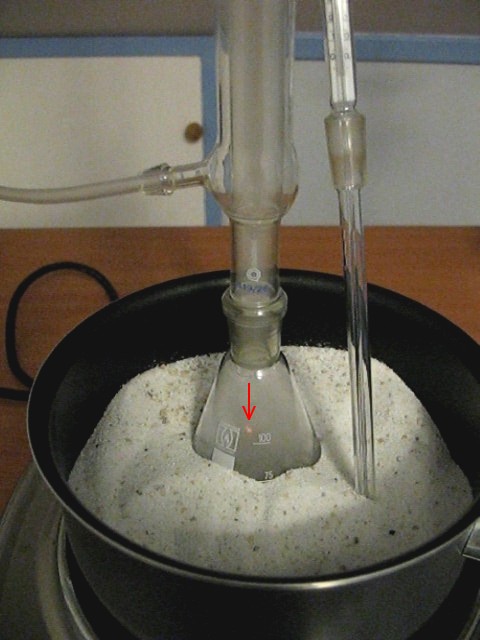
It only is a small flash, but if the erlenmeyer were filled with air, then it could ignite all of the solvent and cause a fire! A small video is made of the very violent reactions in the initial stage of heating up.
The temperature will rise further and at a certain point, the white fumes become less dense and the bubbling is more constant. There are no violent eruptions anymore. This situation is reached at approximately 170 °C, as shown in this small video. When this situation is reached, then the cooler should be disconnected from the erlenmeyer and the gas and vapor must be allowed to leave the system. This gas is hydrogen and the vapor may contain some water and it is best to get rid of that. The cooler may also be wet inside. Just keep it open for a few minutes. The gas and vapor leaves the cooling tube and if drops of liquid collect at the bottom of the cooler, just wipe them off with a paper tissue.
Keep the erlenmeyer open for a few minutes and then reconnect the cooler. Most (if any) of the water now will have disappeared from the system and the bubbling will be less vigorous. Allow the temperature to rise further to 220 °C. During this, there only will be some simmering of the liquid.
![]()
Second step, adding the tert-butanol
Once the temperature has reached 220 to 230 °C, it is time to add the tert-butanol. This must not be added at once, but in a few steps. Use the mix of aliphatic solvent and tert-butanol, as prepared during the setup of the experiment. You will have approximately 8 ml of this mix.
Add 2 ml of this mix. Add this through the top of the cooling tube, use a small funnel in order to avoid dripping liquid in the hot sand. Do not open up the apparatus. Swirl the contents of the erlenmeyer once after adding the tert-butanol. Immediately after adding the tert-butanol there will be somewhat more vigorous refluxing, but this soon subsides again.
Add the remaining 6 ml in steps of 2 ml. Wait 10 minutes between additions and perform a brief swirl after each addition.
![]()
Final step, refluxing and slow reaction, formation of potassium
After addition of the last portion of 2 ml of solvent/tert-butanol mix the contents of the erlenmeyer must be allowed to boil and reflux for a period of approximately 3½ hours at a sand-temperature between 220 °C and 240 °C. At a sand-temperature of 220 °C there is a gentle simmering of the liquid, as shown in this video.
Initially, the liquid remains clear. The video also demonstrates that. But after a period of 1 hour, the liquid becomes somewhat turbid. After 2 hours of refluxing the liquid is turbid and fairly dark grey. The remaining period of refluxing the liquid stays like that. During the 3½ hours of refluxing the temperature was monitored and the hot plate was adjusted such that it never fell below 220 °C and never rose above 250 °C.
After 1½ hours of refluxing one can clearly see small sub-mm sized globules of potassium and after 2 hours of refluxing these globules already have a diameter of around 2 mm. The picture below shows these globules (the sand was scraped away but after taking the picture the hot sand was put back again). The picture also shows how dark and turbid the liquid is.
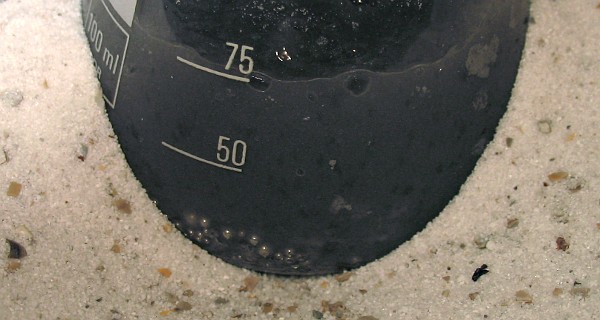
After 3½ hours of refluxing the erlenmeyer was taken out of the hot sand. At that time it still was turbid and grey. The grey, however, is lighter than after 2 hours of refluxing. Most of the small globules of potassium have coalesced into larger balls of potassium. In this particular experiment, three big balls of potassium had formed. These balls were laying on a grey crust, which seems to be a mix of unreacted magnesium and magnesium oxide.
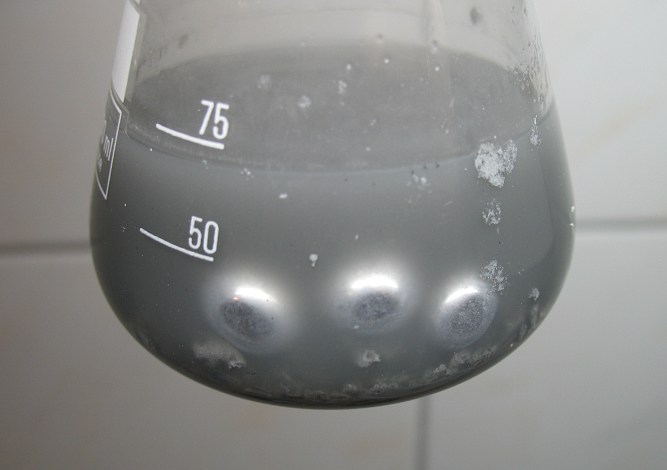
The following two videos show the liquid balls of potassium in the still hot liquid while the erlenmeyer is swirled: one ball of potassium and two balls of potassium. At the moment of making the videos the third ball of potassium still was not yet discovered, it was hidden in the turbid liquid and the swirling did not move it out of its place.
![]()
The next day . . .
The erlenmeyer with the hot liquid and the balls of potassium was stoppered and set aside for cooling down. The next morning, the liquid was clear and the balls of potassium had solidified.
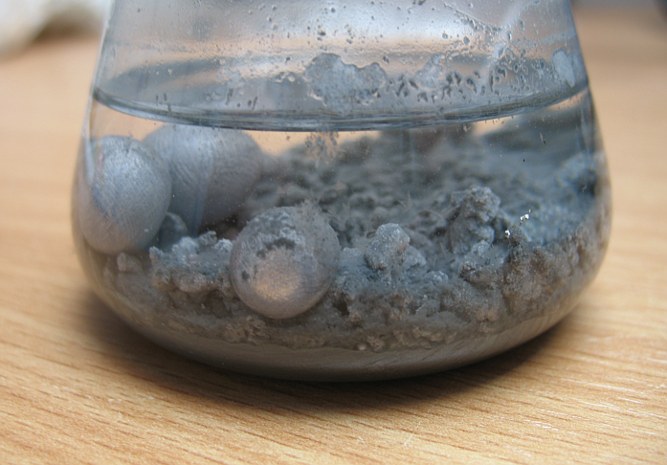
The picture shows the crust of gray material and the three balls of potassium. Inside the crust, there are many more balls of potassium, but these are small. Most of them have a diameter of less than 1 mm, some of them are slightly larger. One of these small pieces of potassium can be seen in in the picture, at the front in the middle, just above the more homogeneous gray layer.
The balls of potassium were taken out of the liquid, rinsed with some fresh aliphatic solvent and then put in a small vial under fresh aliphatic solvent.

The balls of potassium show some remarkable surface features. There are stripes on the balls of potassium and there also are bluish spots. The stripes are shown in the picture below and the smaller picture shows the blue spots.
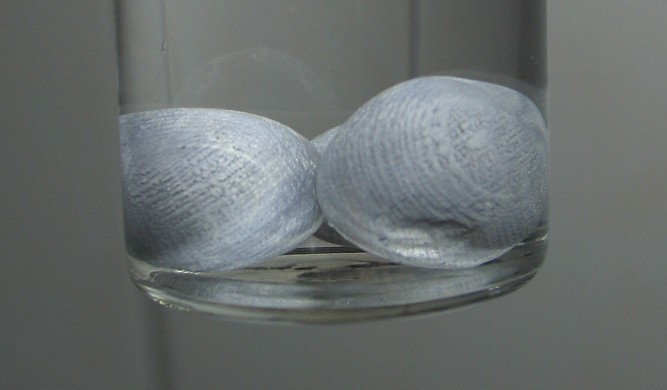
The potassium looks remarkably clean. It might be that it contains some dissolved magnesium, but the surface of the potassium balls could very easily be cleaned. A simple rinse with some cold aliphatic solvent was sufficient to get rid of the gray material in the erlenmeyer.
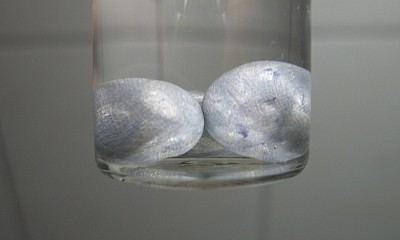
The total amount of potassium, isolated in the form of the three balls is around 3 grams. More potassium is present in the form of very small balls, but this is not isolated.
![]()
Discussion of results
The reactions involved in this synthesis are rather complex. A set of different reactions occurs, in which the tert-butanol (written as t-BuOH) and the subsequently formed potassium tert-butoxide (written as t-BuOK) play an important role. The active species, which is reduced by magnesium is the t-BuOK.
Initial reaction, before addition of tert-butanol
In the initial reaction (at 130 to 150 °C), before addition of the tert-butanol, the moisture in the potassium hydroxide reacts with the magnesium, releasing hydrogen. The water, present in the potassium hydroxide also partially is released in this reaction as vapor. Apparently this reaction is very exothermic, so much that it even is accompanied with flashes of fire.
Mg + H2O → MgO+ H2
KOH,H2O → KOH + H2O(g)
Here KOH,H2O stands for water, attached to the KOH. Commercial KOH contains 10 to 15% of water, which is strongly attached to the KOH.
It is remarkable that release of water only occurs when magnesium is present. When KOH is heated in Shellsol D70 with no magnesium added, then no water is released, so the presence of magnesium is required for the release of the water. Most (or maybe even all) of the water reacts to form hydrogen gas and MgO.
So, after the initial reaction, part of the magnesium is converted to MgO by water, present in the KOH.
Reaction after addition of tert-butanol
When the tert-butanol is added, then initially this slowly reacts with KOH to form t-BuOK and water:
t-BuOH + KOH → t-BuOK + H2O(g)
Only very small amounts of t-BuOK are formed according to this reaction. Once, some t-BuOK is present, the reaction proceeds along the following steps:
![]() The t-BuOK dissolves in the aliphatic solvent and in this
form it can start a liquid phase/solid phase reaction with the magnesium.:
The t-BuOK dissolves in the aliphatic solvent and in this
form it can start a liquid phase/solid phase reaction with the magnesium.:
2 t-BuOK + Mg → (t-BuO)2Mg + 2K
The K-metal, formed in this reaction, reacts with free t-BuOH as long as this is present:
2 t-BuOH + 2K → 2 t-BuOK + H2
These steps together cause a strong increase in the concentration of t-BuOK and this goes on, until no more free t-BuOH is present anymore. When no more free t-BuOH is present anymore, then the potassium does not react any more and it forms globules of liquid metal.
![]() The (t-BuO)2Mg reacts with further KOH,
giving MgO and new t-BuOK, together with free t-BuOH:
The (t-BuO)2Mg reacts with further KOH,
giving MgO and new t-BuOK, together with free t-BuOH:
(t-BuO)2Mg + KOH → MgO(s) + t-BuOK + t-BuOH
![]() The t-BuOH reacts with already formed potassium, releasing hydrogen gas and
forming t-BuOK:
The t-BuOH reacts with already formed potassium, releasing hydrogen gas and
forming t-BuOK:
2 t-BuOH + 2K → 2 t-BuOK + H2
All reactions above lead to the formation of potassium, which slowly forms globules, which in turn coalesce into big balls of potassium. The next section gives a more quantitative analysis of how much potassium is formed.
Net amount of potassium formed
Besides the initial reaction in which t-BuOK is converted to t-BuOK, the rest of the reactions do not lead to net production or consumption of t-BuOK. When all reactions are combined, then the following net-reaction equation can be given:
2Mg + 2KOH → 2MgO + 2K + H2
The real amount of potassium formed is lower than what can be expected on the basis of the above equation, because part of it is consumed in the formation of t-BuOK:
2 t-BuOH + 2K → 2 t-BuOK + H2
In the experiment, described in this page, 7 grams of KOH were used and 3.5 grams of Mg were used. Let's assume 10% of the KOH consists of water, then 0.7 grams of water were present. Assume most of this reacts with Mg to form MgO and H2. Then 0.94 grams of Mg are needed to destroy that water. What remains are 6.3 grams of KOH and 2.56 grams of Mg.
Now, Mg becomes the limiting reactant. With 2.56 grams of Mg, 4.1 grams of K-metal can be formed. This 4.1 grams of K-metal is not the final yield. Part of it is consumed in the formation of t-BuOK. The amount of t-BuOH added was 0.7 ml, which is 0.55 grams of t-BuOH. Converting all of this to t-BuOK requires 0.29 grams of potassium. So, the ideal yield will be 3.8 grams of potassium.
In the experiment, 3 balls of potassium were produced plus many very small ones which were not isolated. The exact volume of potassium is hard to estimate, but it will be somewhere between 3 and 3.5 ml, which means that around 3 grams of potassium is isolated. The isolated yield hence will be somewhere between 75% and 80%. When all small globules are taken into account as well, then the yield of potassium may even be 90% or better. But the latter figure is not really significant, what counts is the amount which is actually isolated.